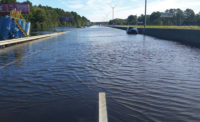After storm surge from Hurricane Matthew undermined a 1.3-mile-long stretch of State Road A1A in Flagler Beach, Fla., causing portions of the coastal highway to collapse, Florida Dept. of Transportation officials estimate that a preferred reconstruction approach could cost up to $35 million and take as long as one year to implement.
That preferred option, modeled after a nearby, 150-ft-long section that FDOT repaired roughly 10 years ago, would be supported by a system of sheet piling and capped by asphalt. But the approach remains up for debate with local agencies, who may prefer a quicker fix, says Noranne Downs, FDOT’s District Five secretary.
“In the past we weren’t on the same page” with local agencies about the best approach to a fix, Downs says. The previously installed 150-ft sheet-pile section withstood Matthew, she says. “We’ll see how our Thursday meeting goes with the locals,” Downs says. “They’re in a hurry to get it up and running. But we think the wall is the best alternative, and we’ve added some upgrades to what we put in 10 years ago that should make it even stronger and sturdier.”
In an emailed response to ENR, Downs specified that potential “upgrades” could include using cathodic protection, thicker steel or enhanced tie-backs to engineer and construct “something that will last for 50 years.”
While sections of A1A in Flagler Beach have previously washed away as a result of storms, this is the most extensive to date, says Steve Olson, public information officer with FDOT. Previous fixes had involved the use of granite or coquina boulders to shore up the dunes supporting the highway, says FDOT. But the agency hopes to avoid that approach this time.
“That didn’t work,” Downs says. “The boulders are all over the place.”
FDOT estimates that it could take a couple of weeks to secure permits. However, says Downs, “We could actually get to contract very quickly if everyone agreed.” A contracting method also is undetermined.






